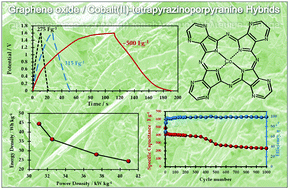High-performance aqueous asymmetric electrochemical capacitors based on graphene oxide/cobalt(ii)-tetrapyrazinoporphyrazine hybrids†
Abstract
A novel asymmetric electrochemical capacitor (AEC) with high energy and power densities has been developed using a graphene oxide/cobalt(II)tetrapyrazinoporphyrazine composite (GO/CoTPyzPz) as the positive electrode and graphene oxide/carbon black (GO/CB) as the negative electrode in a neutral aqueous Na2SO4 electrolyte. The excellent specific capacitance, energy and power densities (∼500 F g−1, 44 W h kg−1 and 31 kW kg−1) coupled with long cycle life, excellent short response time, and low equivalent series resistance clearly indicate that this new material has great potential for the development of low-cost and ‘green’ aqueous AECs that operate at high energy and power densities. Interestingly, the energy density of the GO/CoTPyzPz//GOCB based AEC falls within the range usually observed for nickel


 Please wait while we load your content...
Please wait while we load your content...